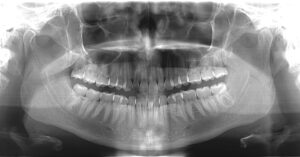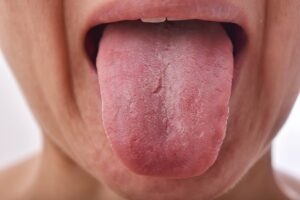Header logo
header top contact widget
Learn More Blog
How A Periodontist Can Help Cancer Patients
Posted on Mar 18, 2024 by William J. Claiborne, DDS MS
For those who learn they have cancer, regardless of the type, it is a frightening diagnosis. While survival rates have been positively increasing over the years, it is a dreaded disease that requires challenging treatment regimens, even for those who have early stage cancer diagnoses.

Thanks to extensive research and advances in treatment options (including high-tech imaging that catches many cancers in their early stages) the survival statistics are climbing at a steady pace. In 2022, 69% of survivors have lived over 5 years since their diagnosis; 47% have lived over 10 years since their diagnosis; and 18% of survivors have lived over 20.
Encouraging, also, is that the number of cancer survivors is projected to increase by 24.4% by 2032.
Treatment for cancer can be very compromising to the immune system. One of the ways to support the immune system is by having excellent periodontal health. Having a healthy mouth can lower the demands on the immune system. Here’s why…
The mouth is home to millions of bacteria; some bacteria are good and some are bad. When the bad bacteria are well-managed (through proper brushing, flossing and regular dental check-ups), the gums remain healthy and protective to the structures below.
When bad bacteria over-accumulate, the immune system becomes strained as it attempts to combat their rapid reproduction. The bacteria become infectious, destroying healthy tissues. This leads to the loosening of gum tissues that snugly wrap the base of each tooth. Thus, bacteria are able to penetrate below the surface of the gums.
Here, bacteria attack the structures that support teeth, including bone. This destruction can cause teeth to loosen, leading to the need for removal in some cases.
Yet, it is not just the immune system that is challenged by the bacteria. Even for those in good overall states, having gum disease increases the risks for many health problems, such as heart disease, stroke, arthritis, diabetes, dementia and even certain cancers.
In a study by Harvard scientists from data that included almost 150,000 adults with a follow-up after 28 years, those with a history of periodontal disease were 43% more likely to develop esophageal cancer and 52% more likely to develop stomach cancer. The risk was even higher in those with gum disease severe enough to cause tooth loss (periodontitis).
Although the exact mechanism connecting gum disease and some cancers is still uncertain, studies continually show correlations. This can be in the form of triggering the onset or worsening those in development.
In one study from the late 1990s until 2012, study participants with severe gum disease showed a 24% higher risk of developing cancer. For edentulous patients (those who have no remaining natural teeth), there was an even higher risk.
As a periodontist, I have a firsthand view of how destructive the infectious bacteria of gum disease can be. Ridding any level of this can reduce the demands on the immune system. As such, we often care for cancer patients to relieve the problems in the mouth that some medications and radiation can cause (such as tissue infections and sores, pain or swelling in the mouth, and sensitivity to hot and cold). This is often done using a dental laser. Laser therapy is very comfortable and is safe for cancer patients and the process can expedite healing greatly.
I’d also like to take this opportunity to address, specifically, oral and oropharyngeal cancers since April is National Oral Cancer Awareness month. While some other cancers seem to be more present in the public eye, awareness of oral and neck/throat cancers needs to be greater. Oral cavity and oropharyngeal cancers occur most often in the following sites:
• tongue
• tonsils and oropharynx (the part of the throat behind the mouth)
• gums, floor of the mouth, and other parts of the mouth
The rest are found in the lips, the minor salivary glands (which often occur in the roof of the mouth), and other sites.
The American Cancer Society’s most recent estimates for oral cavity and oropharyngeal cancers in the U.S. are for 2024:
– About 58,450 new cases of oral cavity or oropharyngeal cancer
– About 12,230 deaths from oral cavity or oropharyngeal cancer
The average age of people diagnosed with these cancers is 64, but they can occur in young people. Just over 20% (1 in 5) of cases occur in people younger than 55.

Adult males are at the highest risk for oral cancer, with black males being the most susceptible. The risk also increases with age, especially after age 50. Although the risk typically peaks between the ages of 60 – 70, males between ages 50 – 59 tend to have the highest numbers.
It is important to be aware of the warning signs of oral cancer, including:
• A sore, irritation, lump or thick patch in the mouth, lip, or throat
• White or red patch inside the mouth
• Feeling something is stuck in the throat
• Difficulty chewing or swallowing
• Difficulty moving the jaw or tongue
• Numbness in the tongue or other areas of the mouth
• Unexplained swelling of the jaw
• Pain in an ear without hearing loss
While these symptoms do not always indicate oral cancer, any that do not clear up on their own within 2 weeks should be examined without delay.
This dental exam is painless. Many patients, if not told, are not aware that the dentist is performing it. During this, the dentist does a visual examination of oral tissues, checking the lips and inside of the mouth (including under the tongue). The dentist will also check the roof and floor of your mouth.
If suspicious areas are noted during the exam, the dentist will order a biopsy. In this, a small sample of tissue from the area of concern is removed and examined under a microscope. This will determine whether further tests are needed.
Unfortunately, the CDC reports that about 35% of adults over the age of 18 did not have a dental visit in 2019. This leaves those who are vulnerable or developing oral cancer at higher risk of it advancing. Those regular dental checkups go beyond the cleaning of teeth and lowering the risk of oral cancers adds greatly to the need to be committed to these appointments.
If you are experiencing symptoms of gum disease, please know that this disease will only worsen without treatment. If you have any of those listed below, please contact our Asheville periodontal dental office as soon as possible to schedule an examination.
Watch for:
Swollen or puffy gums
Bright red, dark red or dark purple gums
Gums that feel tender when touched
Gums that bleed easily
Seeing pink in the sink or toothbrush after brushing
Spitting out blood when brushing or flossing teeth
Bad breath that won’t go away
If fear has kept you from having regular dental care, our Western periodontal dental office offers both oral and I.V. sedation (twilight sleep). Feel free to call 828-274-9440 to arrange a consultation appointment to discuss any concerns you have regarding treatment or payment plans.
Sources:
Recent Posts
Categories
Archives
- September 2024
- August 2024
- July 2024
- June 2024
- May 2024
- April 2024
- March 2024
- February 2024
- January 2024
- December 2023
- November 2023
- October 2023
- September 2023
- August 2023
- July 2023
- June 2023
- May 2023
- April 2023
- March 2023
- February 2023
- January 2023
- December 2022
- November 2022
- October 2022
- September 2022
- August 2022
- July 2022
- June 2022
- May 2022
- April 2022
- March 2022
- February 2022
- January 2022
- December 2021
- November 2021
- October 2021
- September 2021
- August 2021
- July 2021
- June 2021
- May 2021
- April 2021
- March 2021
- February 2021
- January 2021
- December 2020
- November 2020
- October 2020
- September 2020
- August 2020
- July 2020
- June 2020
- May 2020
- April 2020
- March 2020
- February 2020
- January 2020
- December 2019
- November 2019
- October 2019
- September 2019
- August 2019
- July 2019
- June 2019
- May 2019
- April 2019
- March 2019
- February 2019
- January 2019
- December 2018
- November 2018
- October 2018
- September 2018
- August 2018
- July 2018
- June 2018
- May 2018
- April 2018
- March 2018
- February 2018
- January 2018
- December 2017
- November 2017
- October 2017
- September 2017
- August 2017
- July 2017
- June 2017
- May 2017
- April 2017
- March 2017
- February 2017
- January 2017
- December 2016
- November 2016
- October 2016
- September 2016
- August 2016
- July 2016
- June 2016
- May 2016
- April 2016
- March 2016
- February 2016
- January 2016
- December 2015
- November 2015
- October 2015
- September 2015
- August 2015
- July 2015
- June 2015
- May 2015
- April 2015
- March 2015
- February 2015
- January 2015
- December 2014
- November 2014
- October 2014
- September 2014
- August 2014
- July 2014
- June 2014
- May 2014
- April 2014
- March 2014
- February 2014
- January 2014
- December 2013
- November 2013
- October 2013
- September 2013
- August 2013
- July 2013
- June 2013
- May 2013
- April 2013
- March 2013
- February 2013
- January 2013
- December 2012
- November 2012
- October 2012
- September 2012
- August 2012
- July 2012
- June 2012

